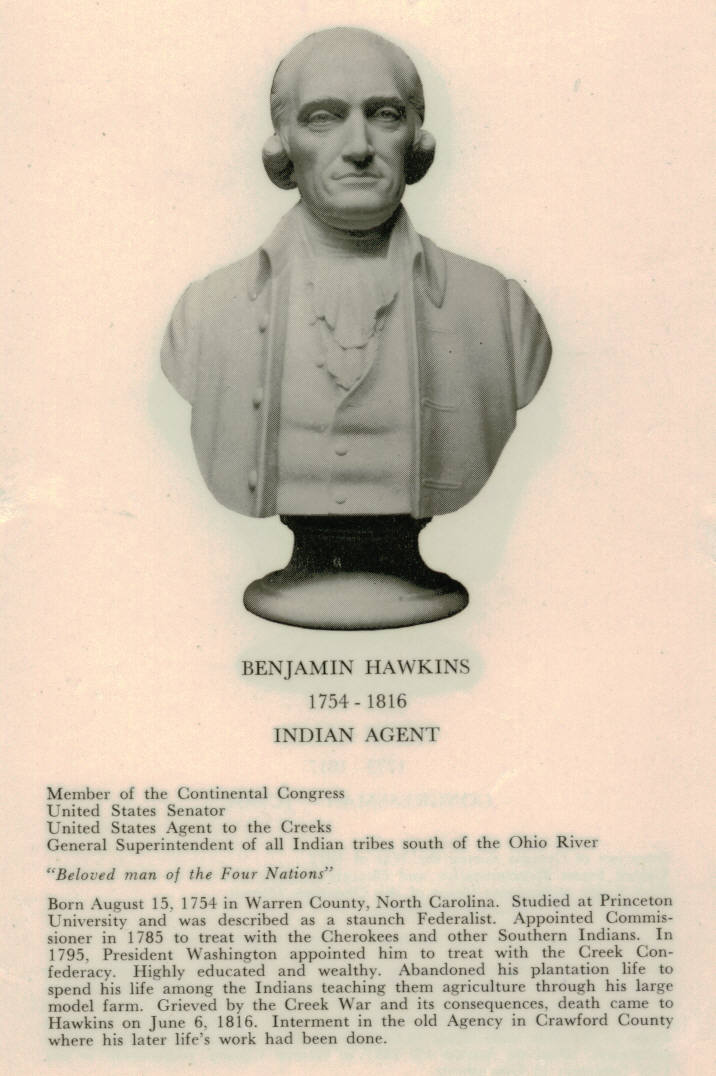
Benjamin Hawkins

Benjamin Hawkins came to Georgia in 1796 as U. S. Agent to the Indian people south of the Ohio River. President George Washington charged Hawkins with resolving disputed land claims between the government and the Creek people.
Hawkins was called "Iste-chatelige-osetat-chemis-te-chango" or "The Beloved Man of Four Nations" by the Cherokee, Chickasaw, Choctaw, and Creek people.
Although the post required him to travel throughout the
south, working principally with the Creeks, he lived most of his term
at the agency he developed on the eastern shore of the Flint River. Beginning
about 1799, he lived in a Creek style or common law marriage with Lavinia
Downs. They moved to the agency in 1801.
There Hawkins taught an agricultural and communal lifestyle
to the Creeks and encouraged them to develop written laws. Historians
have described the Creek Agency as a model farm that included mills, work
shops, and store houses. His love of peach trees is probably the source
of our area's development of the fruit.
Hawkins oversaw the longest era of peace between the members of the Creek Confederacy and the United States. He lobbied for construction in 1806 of the fort in Macon that would bear his name and was responsible for the construction of Ft. Lawrence on the western side of the Flint River.
By the time of the Creek Wars of 1812-1814, Hawkins was at odds with the federal government, in particular President Andrew Jackson, over treatment of the Creek people. After the war, Hawkins' influence on the Creeks declined, as did his health. Expecting to die, he asked Moravian missionaries at the agency to conduct a marriage ceremony Jan. 9, 1812, legitimizing his children. His health improved, and Lavinia bore his last child, Jeffersonia, in 1813.
Hawkins was retiring and was in the process of selecting
a successor when he died at the Creek Agency June 6, 1816. He was buried
there, and a historic marker and memorial stone mark what is believed
to be the spot, overlooking the Flint River. Hawkins' estate was probably
worth more than $100,000 and included what historians have called one
of the finest personal libraries in frontier country. Jones
County probate records list witnesses to his will as John Jameson,
Christian Lumbough, and Thomas M. Ellis (See William Ellis), and mention
brother-in-law Henry Carr.
Lavinia died March 22, 1828 in Crawford County, and was
buried at Fort Hawkins. Benjamin and Lavinia had six children and adopted
another. They were:
1. Georgiana (b. May 4, 1799, d. Feb. 12, 1818 Jones Co., GA);
2. Muscogee (adopted, b. Jan. 30, 1802);
3. Cherokee (b. March 16, 1805, d. Feb. 26, 1849 Water Valley, Yalobusha
Co., MS);
4. Mary Caroline (b. June 10, 1807, d. April 12, 1817);
5. James Madison (b.1809 GA, d. after March 18, 1850 Yalobusha Co., MS);
6. Virginia (b. March 6, 1811 GA, d. Oct. 3, 1851 Water Valley, Yalobusha
Co., MS);
7. Jeffersonia E. (b. July 12, 1813, d. Nov. 15, 1861, Crawford County,
buried Roberta City Cemetery).
This page was last updated Tuesday, November 08, 2005 03:57 PM
Copyright
© Kim Gordon
← Webmaster
All Rights Reserved